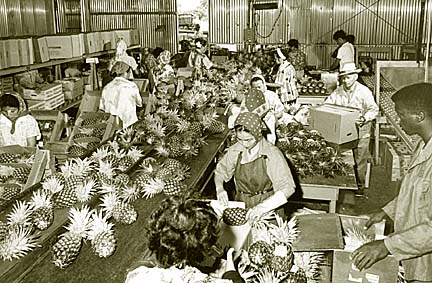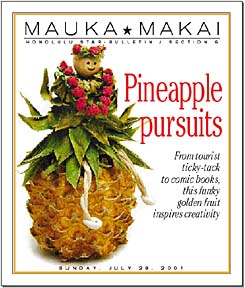

[ MAUKA MAKAI ]

Pineapple cannery I was 16 the summer of 1971. It was time to start paying my own way, pick up some seasonal work and help pay for my private school tuition. And as part of my passage into adulthood and the local workplace, it was my time to participate in that summer rite that seemingly every teen of my generation, and generations before me, was expected to complete: to be a seasonal Dole pineapple worker.
provided a teen
rite of passage
COVER STORY
By Burl Burlingame
bburlingame@starbulletin.comBut there was no way I was going to spend the summer on Dole's Lanai plantation, wearily plucking the prickly crowned fruit from the soil, what with the sun and the dirt. No, I decided, I was going to play it smart -- or as smart as I could be for a naive 16-year-old. I opted to work in the cannery on Iwilei Road, under the landmark pineapple tower. And, better yet, I'd gladly work the graveyard shift, because it paid more! No problem and, besides, it would only be a three-month stint. How bad could it get?

Simply put, it was the worst job I've ever had to slog my way through. The other menial, low-paying job I would have for the remainder of my high school years would be as a sales clerk at the old McInerny stores, first at Ala Moana Center and then in Waikiki, but even my junk days at the store could never compare to the sheer daily tedium of the cannery job.I'm not saying I was a wuss -- well, OK, I was a bit of a complainer -- nah, to be truthful, I was wussy! I really tried to do the best I could, but I distinctly remember one morning when I came home after my father picked me up from work, reeking of pineapple on my work apron and clothing, showering, falling asleep from exhaustion, getting up, eating dinner and then later refusing to budge from my bed, tears streaming from my eyes, and attempting to tell my folks, between sobs, that I didn't want to go to work in a couple of hours.
It worked that once, but I resigned myself to the job for a little while longer, then, if I remember correctly, I quit the cannery before the season was up.
While I occasionally trimmed the "eyes" of the skinned fruit as they passed by on conveyor belts (thankfully avoiding slicing any of my fingers in the process of handling the slippery yellow fruits) or watched over a machine that ground up the waste into pulp used for something-what-I-don't-want-to-recall-maybe-it-was-feed?-or-fertilizer?-ah-the-hell-with-it!, my main job was as "seamer operator."
Basically, another person (usually one of two older local Japanese women) and I watched a line of silver cans fill up with hot, steaming pineapple juice, then get sealed.
My co-workers were pleasant enough to work with but hard for a teen to relate to. There really wasn't a way to talk anyway, what with a large metal bin above us being constantly filled with empty cans, the clattering constantly filling the heavy, steamy air. The woman would sit across me, looking for defective cans, while I stood on a greasy workbench making sure the filled juice cans went into the seamer with no problem.
That is, until one can, for some reason, would jam up the machine as its cover would fly open, spilling and spraying hot pineapple juice all over me while I rushed to hit the machine's stop button before more cans leading into the machine were crushed. That's when our supervisor, who was usually smoking a cigarette, begrudgingly walked up with a crowbar in hand to loosen the now-wedged cans and throw them away.
If we were "lucky" enough, minor repairs would need to be done, so we would have some unscheduled downtime. But what I looked forward to was the late-night meal break, where learning to eat and fall in love with the tomatoey and chewy tripe stew that was occasionally on the menu is the only lasting legacy of that job. After the meal, I would usually go to the locker room to lie down on one of the benches and read my Richard Brautigan book. I fell asleep once, only to be roused by the supervisor.
I always looked forward to the early morning light streaming into the cannery, knowing my shift would end soon. I would steam-clean the machine and the area around it, pineapple juice and greenish globs of machine grease being pushed along by the streaming hot water into open floor drains that probably polluted whatever body of water they ended up in.
For at least a good year after that rite of passage, I couldn't even look at pineapple juice, whether in the can or in a glass. But I'm sure that could be said for any of the hapless workers who passed through the doors of the cannery at all hours of the day, getting that island-grown product all over the world to consumers who only knew the romance of the fruit -- not the dreary process of bringing it to the table.
Click for online
calendars and events.